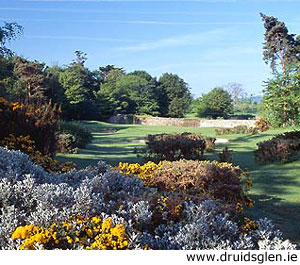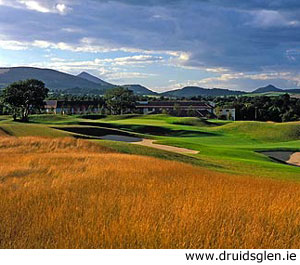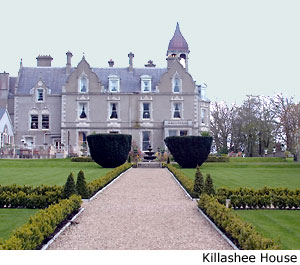"Slainte" (Cheers) to Ireland
Lesser-known Irish parkland golf courses well worth seeking out
by Dale Leatherman Mention golf and Ireland in the same breath and the image of links courses comes to mind. True, many of the world's best links courses are here, but there are also parkland courses well worth a trip inland.
Mention golf and Ireland in the same breath and the image of links courses comes to mind. True, many of the world's best links courses are here, but there are also parkland courses well worth a trip inland.
"Caed Mille Failte." One hundred thousand welcomes. The oft-repeated Gaelic phrase is symbolic of the Irish, a people given to natural ebullience—and sometimes exaggeration (i.e, the Blarney Stone). But the friendliness of the Irish is not exaggerated. Nor is their claim to a lion's share of the finest golf courses in the world.
An island slightly smaller than the state of Indiana, Ireland has 402 courses, more than any other country of comparable size. Many of them are the stuff of legend—Lahinch, Ballybunion, Royal County Down, Portmarnock, County Sligo, Donegal, Rosapenna, Portstewart, Ballyliffin, to name a few. Others have escaped international attention, but stand ready to reward the golfer who seeks out lesser-known tracks, the gems favored by locals.
Forty percent of the world's true links courses are here, scattered along 3,000 miles of Ireland's ruggedly beautiful coastline. But Irish golf has a fitting yin to the linksland yang—parkland courses as fair and beguiling as any garden, where flowering plants and dancing waters offer consolation if the layout becomes punishing.
Faced with a very short stay on the Emerald Isle, I chose to save the links courses for another time and seek out two resorts known for their parkland layouts. I drove 20 minutes south of Dublin to the "Garden of Ireland," County Wicklow, and a resort known for its garden-like setting—Druid's Glen Golf Resort. The 400-acre enclave lies between the Wicklow Mountains and the Irish Sea near the small village of Newtown-mountkennedy.
Druids Glen Golf Resort
Ten years ago architects Par Ruddy and Tom Craddock were asked to create the best parkland course in Ireland, no matter what the cost. As a measure of their success, the Druids Glen Course is known as the "Augusta of Europe," and Augusta would have to go some to top it visually when the thousands of azaleas, rhododendrons, magnolias, gorse and other flowering plants are in full bloom. A variety of mature trees, an abundance of tumbling waterfalls and pools, historic stone bridges and hedges clipped into symbolic designs make this a garden of earthly delights with a golf challenge to match.
A year after Druids Glen opened in 1995, the 7,046-yard track hosted the Irish Open and continued to do so through 1999. It was also the venue for the 2002 Seve Cup between Ireland and Great Britain and continental Europe. Many European players and officials have called it one of the best venues on their pro tour, and Colin Montgomerie, two-time winner of the Open, says the Glen's thirteenth hole is the toughest on the tour.
The hole in question, a 471-yard par 4 called "the Snake," is a dogleg from a very elevated tee to a slender, angled fairway alongside a stream. It takes a long second shot across water to reach the green, and conservative recreational players settle for a three-stroke approach. On the hillside beneath the championship tees, the course's full-time gardener has sculpted hedges in pale green "snakes." Linking tees and fairway is Three-Eye Bridge, an ancient stone span with three arches over a rambunctious stream.
Thirteen is the signature hole, but it is the twelfth that gives the course—and the resort—its name. During construction of the hole, workers discovered a 12th-century altar used for worship by the Druids, the priests of ancient Celtic society. A statue of a Druid now overlooks the altar and the green.
 Before my round, players' assistant Desmond Byrne escorted me through Woodstock House, the restored 1770s mansion that is now the course clubhouse. In the basement, a small museum is housed in a tunnel used by the staff to enter the house. That way, the owners' view across the great expanse of the estate was not spoiled by the presence of servants walking to work. The nearby Spike Bar, a breakfast area with a vaulted stone ceiling, was originally the wine cellar. On the main floor is a comfortable bar with deep leather chairs overlooking waterfalls tumbling past the eighteenth green.
Before my round, players' assistant Desmond Byrne escorted me through Woodstock House, the restored 1770s mansion that is now the course clubhouse. In the basement, a small museum is housed in a tunnel used by the staff to enter the house. That way, the owners' view across the great expanse of the estate was not spoiled by the presence of servants walking to work. The nearby Spike Bar, a breakfast area with a vaulted stone ceiling, was originally the wine cellar. On the main floor is a comfortable bar with deep leather chairs overlooking waterfalls tumbling past the eighteenth green.
Out in front of the clubhouse, flags of several nations snapped in the breeze. It is the club's custom to fly the flag of every golfer scheduled that day. On the underside of his cart roof, Byrne had jotted phrases translated from more than 20 languages so that he could greet players with a familiar remark. During my stay I found that this sort of personal attention seemed to be de rigueur for the resort staff.
Aside from scoring, playing Druids Glen was literally a walk in the park. The second hole, a par three from an elevated tee, drops to a green beside a 12-foot stone wall that has surrounded the estate for more than two centuries. An arched opening in the wall leads to the third tee, set in a former orchard now replanted in fruit trees. A curve in the wall gives space to a pair of gnarled redwoods that would have been saplings when the wall was built.
One beautiful hole follows another, presenting fresh challenges and views at every turn. Fairways parallel each other in only two instances, so there is a wonderful air of seclusion as the route winds through wooded garden-like copses and across meadows bordered by tall yellow gorse. Three of the four par 3s play across still pools with cascading falls nearby, including the 17th, which has an island green. Another is the twelfth, where the bank of the elevated tee boxes is decorated with a huge Celtic cross sculpted in shrubs and flowers. The finishing hole, a 450-yard par 4, plays uphill alongside a succession of waterfalls, culminating in a diagonal water crossing to the green.
Druid's Glen has a new companion course, Druids Heath, which occupies a plain 300 feet higher than the Glen, with distant vistas of the sea. Stretching 7,434 yards, the Thomas Ruddy design is a combination heath and links style with few trees, but riddled with gorse, heather, pot bunkers, rock quarries and streams. In difficulty it is a good match for the Glen, especially when the wind sweeps off the sea. The toughest hole is the twelfth, a 492-yard par 4 that calls for a heroic drive and a long second to a sloped green. Two of the par 3s are long, considering the wind—the 233-yard third hole and the 250-yard eleventh. Eighteen is another memorable finishing hole—a 415-yard par 4 channeled through a keyhole of trees to a landing area ringed by bunkers and an elevated green demanding a fly-in approach.
The Marriott Druids Glen Hotel & Country Club is Wicklow's only five-star resort. Though built in a modern style, stone and wood used in the construction and furnishings give the hotel a natural feel. In addition to 148 large rooms and suites, the building contains an exceptional spa with swimming pool and more than 8,000 square feet of space for large gatherings. Flynn's Steakhouse, with its fireplace and views of Druids Glen, was my favorite place for beef and seafood.
Another great spot is the Thirteenth Bar, where I met with Denis Kane, CEO of the resort, for a Bushmills (the Irish way, with no ice and just a dash of spring water to release the whiskey's flavor). Kane is a left-handed golfer, as I am, so we were able to discuss the nuances of the courses as kindred spirits.
The K Club
 My next destination was Killashee House, a 17th-century stone manor house near Naas in County Kildare. A bell tower looms over the structure, a reminder of its use in the 1920s as a boys' prep school run by the local La Sainte Union Nuns. Today the historic house is comfortably fused to an elegant hotel with large rooms appointed with period furniture. Hidden behind the stately edifice is a thoroughly modern spa and exercise facility with a large indoor pool.
My next destination was Killashee House, a 17th-century stone manor house near Naas in County Kildare. A bell tower looms over the structure, a reminder of its use in the 1920s as a boys' prep school run by the local La Sainte Union Nuns. Today the historic house is comfortably fused to an elegant hotel with large rooms appointed with period furniture. Hidden behind the stately edifice is a thoroughly modern spa and exercise facility with a large indoor pool.
I chose Killashee House because it is within easy reach of the Irish National Stud, the Currragh Racecourse and the K Club, with its grand hotel and country club set among 700 acres of gardens and ancient forest along the River Liffey. The K, of course, stands for "Kildare," from the Gaelic "cill" (church) and "dair" (oak).
But the name on many lips these days is Arnold Palmer, who designed the course for Ireland's first Ryder Cup, September 22-24, 2006.
As I waited my turn on the first tee of the Palmer Course, the starter, Sean, and I discussed this passage in the course guide: "If ever a golf course reflected the personality of its architect, it is surely the course Arnold Palmer designed at the K Club. It may seem odd to describe a golf course as charismatic and cavalier but from the instant you arrive at the first tee you are enveloped in a unique atmosphere. You may have been forewarned that . . . [it] is no ordinary golf course, and that it is widely acknowledged as the country's most challenging layout, but still you will be unprepared for the ensuing drama."
Sean concluded that the course was deceptive, with trouble lying in the most innocent-looking places.
After this build-up, and having experienced other Ryder Cup venues, I approached the course with some trepidation. However, I found the gently rolling layout to hold no big surprises for the recreational golfer; trouble is always visible. Avoiding it is another issue. Palmer makes you exercise some strategy and work for your score, but the route is not overly penal. Of course, it will be a different story for the Ryder Cup teams playing from championship tees to narrow fairways lined with three-inch rough.
The opener is an unassuming par five, but the next seven holes feature water hazards, including the memorable par-3 fifth hole, "Church Fields," backed by the ruins of a church and a waterfall that feeds a stream coursing in front of the green. The seventh hole is a 600-yard double dogleg lined with flowering trees and shrubs, but rife with water, sand and rough. It culminates in a small green cupped between two branches of the Liffey, accessed by a 19th-century iron bridge. A wooded walk to the eighth tee passes a pretty garden and fountain and offers a view of the imposing backside of the Kildare Hotel. The fairway and green hug the river, which widens into cruising territory for regal swans.
The back nine is home to picturesque par-3s and a tricky trio of par-4s that concludes with an island green on the sixteenth hole. Palmer's finishing flourish, a 537-yard par 5 named "The Hooker's Graveyard," tempts big hitters to drive over a hill riddled with bunkers and then go for a green closely guarded by water and a nest of bunkers. Cooler heads will play three shots to the green.
Palmer's mandate for the resort's newer Smurfit Course was to make it entirely different from the Palmer track. Mission accomplished. A links-style course but with no ocean roaring in the wings, the track does have 14 acres of water and lots of dune-like mounding. While the parkland Palmer Course features cultured plantings, the Smurfit is a random riot of bracken, gorse and other wild vegetation, with four islands serving as wildlife havens.
The 69-room, 25-suite Kildare Hotel at the K Club offers every conceivable luxury and all the activities you'd expect at a five-star resort. If you're in the market for a second or third home, resort development is booming—massive homes and condos are sprouting up on both courses.
When visitors arrive at my door these days, they see a knocker inscribed with "Caed Mille Failte." I always hope they ask, so I can explain the meaning and the hospitality of the Irish. It's also a reminder to me that I have a lot to live up to.
For more information on:
Ireland: http://www.tourismireland.com
Druids Glen Resort & Country Club: http://www.druidsglen.ie
The Kildare Hotel & Country Club (K Club): http://www.kclub.ie
Killashee House: http://www.killasheehouse.com
Links Golf Trips: http://www.westcoastlinks.com

